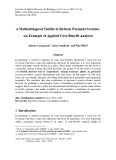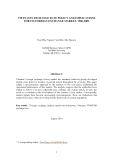
Reform payment systems
-
Ebook Banking and insurance: Part 1 presents the following content: Indian Banking System; Reserve Bank of India; Concept of Retail Banking; Treasury Management & Banking Sector Reforms; Payment and Settlement System;...Please refer to the documentation for more details.
 139p
139p  chankora
chankora
 16-06-2023
16-06-2023
 4
4
 3
3
 Download
Download
-
The purpose of this paper is to explore a best practice framework for the regulation of payment services. It will discuss and assess some models as potential law reform concepts to be further developed. This paper will consider some possible models for the regulation of payment services involving the key elements of disclosure, minimum standards, prudential regulation and conduct licensing. It will also discuss supervision of the inter-bank payment system and a basic fair play regime. A possible regulatory model will be suggested as a contribution to future debate.
 63p
63p  runthenight04
runthenight04
 02-02-2023
02-02-2023
 3
3
 1
1
 Download
Download
-
In principle, a careful evaluation of costs and benefits should be a wise rule for everyone who has to take any important decision. In particular, it is very important when a payment system reform is at stake. Since many stakeholders are involved in a payment system reform, the final decisions are going to be the result of several cost-benefit analyses and of “negotiation” among economic agents, in particular system providers, system participants, and end users. In this paper we will only focus on cost-benefit analysis, providing both theoretical guidelines and numerical examples.
 14p
14p  trinhthamhodang2
trinhthamhodang2
 19-01-2020
19-01-2020
 44
44
 1
1
 Download
Download
-
ABSTRACT Vietnam’s foreign exchange (forex) market has remained relatively poorly developed despite more than two decades of general reform throughout the economy. This paper adopts a microstructure approach to the analysis of the root-causes underlying the operational deficiencies of this market. The analysis suggests that the authorities have tended to follow a de facto adjustable peg exchange rate regime which, in turn, has acted as a retardant to the development of the country’s forex market. Consequently, market signals have become increasingly non-transparent.
 31p
31p  aaronnguyen0610
aaronnguyen0610
 07-04-2013
07-04-2013
 88
88
 9
9
 Download
Download
-
In addition to substantive reforms of the authorities and practices of regulation and supervision, the proposals contained in this report entail a significant restructuring of our regulatory system. We propose the creation of a Financial Services Oversight Council, chaired by Treasury and including the heads of the principal federal financial regulators as members. We also propose the creation of two new agencies.
 294p
294p  mebachano
mebachano
 01-02-2013
01-02-2013
 62
62
 10
10
 Download
Download
-
The general analytical approach of this report is to consider FMIs as multilateral systems, inclusive of their participants, as stated in the definition of FMI. In market parlance, however, the term FMI may be used to refer only to a legal or functional entity that is set up to carry out centralised, multilateral payment, clearing, settlement, or recording activities and, in some contexts, may exclude the participants that use the system. This difference in terminology or usage may introduce ambiguity at certain points in the report.
 116p
116p  enterroi
enterroi
 02-02-2013
02-02-2013
 63
63
 8
8
 Download
Download
-
Since the mid-1990s, the Indian financial system has been steadily if incrementally deregulated and more exposed to international financial markets. Its rapid transformation has been accompanied by strong economic growth, increased market robustness, and a considerable increase in efficiency. Reforms are continuing with the development of appropriate market regulation and an associated payment and settlement system, as well as greater integration into global financial markets.
 0p
0p  enter1cai
enter1cai
 16-01-2013
16-01-2013
 56
56
 4
4
 Download
Download
-
Reforming and liberalizing financial markets began in the wake of the country’s 1991 balance-of payments crisis. The thrust of these reforms was to promote a diversified, efficient and competitive financial system, with the ultimate objective of improving the allocation of resources through operational flexibility, improved financial viability, and institutional strengthening. The pace of reform was, however, slower than those in product markets, partly because the introduction of stricte prudential controls on banks revealed significant problems in asset portfolios.
 55p
55p  enter1cai
enter1cai
 16-01-2013
16-01-2013
 24
24
 2
2
 Download
Download
CHỦ ĐỀ BẠN MUỐN TÌM





















